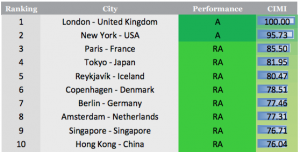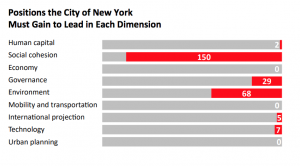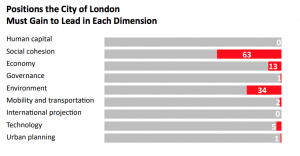For the seventh consecutive year, we are pleased to present the new edition of our Cities in Motion Index (CIMI). Publishing such a report during the COVID-19 health crisis has invited us to reflex on how the pandemic affects cities today and how it will shape them in the future. As cities worldwide went on lockdown, we observed empty streets, closed businesses, and great acknowledgment of our essential workers.

Figure 1. Barcelona city-center June 2020 (confined due to COVID-19)
Source: Renata Cleaver Malzoni
In this context, we present the 2020 CIMI Index. Many of the pillars considered in our Cities in Motion Index will be essential to build resiliency moving forward. To this point, we have worked to develop a comprehensive, wide-ranging, and guided index, with criteria of conceptual relevance and practical utility. This year’s index analyses 101 indicators (five more than last year’s edition) across 9 key dimensions: human capital, social cohesion, the economy, governance, the environment, mobility and transportation, urban planning, international projection, and technology, reflecting both objective and subjective data to offer a comprehensive view of each city.
We have also introduced an online CIMI Calculator for this edition. It’s a useful and practical tool both for those cities that are already reflected in the ranking and which wish to see the changes that occur with more up-to-date variables, as well as for those that are not in the CIMI but would like to know where they stand in the ranking.
As we move forward in the global pandemic, urban managers continue to address many traditional obstacles in cities, such as pollution, mobility, and inequality. COVID-19 has both highlighted some of these challenges, as well as added extra pressure in building a safe and healthy environment for people to live, work and enjoy life. We hope our index is a useful tool for cities to understand their strengths and weaknesses in order to develop a smart strategy in such unprecedented times.
General Index
This year’s index looked at 174 cities across 80 countries, of which 79 are capital cities. The 2020 Index presents the same cities as the 2019 Index. However, it is important to note that changes were made to the methodology of the Euromonitor database (one of the key sources of data for the index) to provide more accurate information. Therefore, the rankings from the two indexes are not directly comparable. More detailed information about this updated methodology can be found in the report.
For the second consecutive year, London takes the first place in the index (#1), followed by New York (#2) and Paris (#3). Six of the top 10 cities are in Europe, with New York being the only representative of North America, and Tokyo, Singapore, and Hong Kong leading in Asian cities.

Figure 2. Top 10 city ranking
London and New York
For the past six editions of the Cities in Motion Index, London and New York have been our top two cities. The British capital, ranked first this year, also led the Index in 2015 and 2019. As for New York, the city led the index in 2016, 2017, and 2018, as well as coming second in our first index of 2014.
In 2020, London is in the top position for two of our nine dimensions: Human Capital and International Projection, as well as being in the top 3 in governance (#2), Urban Planning (#2), and Mobility and Transportation (#2). As for New York, the city is in the top position for three of the 9 dimensions: Economy, Urban Planning and Mobility and Transportation. It is also ranked within the top 10 in Human Capital (#3), International Projection (#6), and Technology (#6).
New York City ranks in #151 in Social Cohesion, one of the city’s greatest shortcomings. Due to the immensity of the challenge, city leaders have presented a plan to improve equality in the city by 2050, including health coverage to New Yorkers independent of financial and/or immigration status.

Figure 3. New York’s Dimension’s breakdown
Social Cohesion is also London’s most considerable struggle, followed by the environment, albeit in both dimensions, the British capital ranks higher than New York City. London has launched the ‘Smarter London Together’ initiative, a smart city project rooted in collaborative work between municipalities and services exchanging experiences to, together, improve their services. London also has a great network of tech experts – the city is home to many start-ups and programmers – and the city plans to work effectively with this expert community to test new technology aimed at improving not only London but cities across the globe.

Figure 4. London’s Dimension’s breakdown
The Need for a Global Vision
Each city is unique, and therefore the strategies and solutions developed are likely to be case-specific. Nevertheless, as we build resilience in a global pandemic, communication and networking are key aspects of a healthy recovery. In this context, the CIMI 2020 reports hopes to contribute by sharing insights and a framework for cities to assess their current situation and best understand what strategy and partnerships will benefit them in these difficult times.
Therefore, one of our key recommendations for 2020 is to recognize collaboration as key aspect for recovery. Our experience with IESE Cities in Motion and the associated PPP for Cities platform shows us that the challenges we face today are too large to be tackled individually. As we move forward, we must work towards breaking down ‘silos’, and build a culture of cooperation – from PPPs to public engagement – working towards an inclusive strategy for social and economic recovery.
As in previous editions, the CIM Index celebrates the importance of putting people first. The lockdowns we observed across the world showed us how cities, without people, are merely empty structures. Recovery will depend on city managers leading by example. We trust that the Cities in Motion report can be a great asset in achieving better governance, which will undoubtedly translate into greater well-being for citizens.
More information on the official website of IESE Cities in Motion.
You can download the full report here: IESE Cities in Motion Index 2020.


Really annoying about the corona virus, Hope it will be gone forever, So hard time this time, Thanks for the information.
Muy buen artículo, enhorabuena.
I found this useful
I’d like to thank you for this wonderful lecture! I loved and enjoyed it certainly.
Yeah, yes
I hope my question’s answer is all right. Thank you and expect updates. Thank you. Thank you, thank you.
It’s a beautifully written article. Thank you
I should concede that your post is truly intriguing. I have spent a great deal of my extra time perusing your substance. Much obliged to you a great deal!
Covid has some serious impacts on every field.
Interesting topic
http://Www.amirvahid.com
It’s a beautifully written article. Thank you
Thanks you for sharing the information
selenium certification
Thanks you for sharing the information
I really enjoyed this website
tableau course
thank you for sharing this article.
data science with r course
Buenos días, estimado Equipo del IESE. Primero que todo les felicito por la valiosa labor que vienen desarrollando con los reportes anuales. En relación al reporte anual del año 2020 les comento un par de observaciones: 1) En la página 68 del archivo en su versión .PDF en la sección titulada RANKING DE LAS CIUDADES MÁS PEQUEÑAS” aparece el siguiente texto: “cierran el top 5 tres ciudades suizas — Wellington, Berna y Ginebra—”, afirmación que debe ser corregida ya que como se puede observar en la tabla que se refleja posteriormente en la misma página Wellington queda ubicada en Nueva Zelanda; 2) En la página 75 aparece en la cual se relacionan las dimensiones economía y capital humano aparece el siguiente texto: “Es decir, en términos generales,las ciudades que tienen mal desempeño en economía difícilmente logran buen desempeño en capital humano y viceversa, si bien hay excepciones, como en los casos de Yakarta, Buenos Aires, Moscú o San Petersburgo, que ocupan una posición relativamente buena en medioambiente pero mala en economía”, texto en el cual la palabra medioambiente debe ser sustituida por capital humano y 3) Como observación de forma en la página 73 aparece el siguiente texto: “LA zona inferior derecha muestra las que presentan un bajo nivel de desarrollo en economía, pero bueno en lo referente a medioambiente”, en la cual la letra a de la palabra la debería ser minúscula. Les reitero las felicitaciones por un valioso documento. Saludos cordiales, Gustavo Machado Núñez
This blog is very nice.
“””SEO UK agency
“””
The IESE Cities in Motion Index 2020, featured on the blog “Cities, Challenges, and Management,” provides a detailed analysis of the performance of 174 cities across the globe in terms of sustainability, quality of life, and other indicators of urban well-being. The article presents the methodology used to compile the index, which includes both objective data and subjective surveys, and provides insights into the factors that contribute to success in urban management. The index rankings and accompanying analysis can serve as a useful resource for policymakers, urban planners, and other stakeholders looking to understand how cities around the world are addressing the challenges of sustainability, resilience, and livability. Overall, this is an informative and well-researched article that sheds light on the complex issues involved in managing cities in the 21st century.
You actually said it fantastically.
Its emphasis on collaboration and the critical role of people in building resilient cities is highly relevant, especially in the context of recovery from the current global crisis. Additionally, the ranking of top cities shows interesting patterns in terms of human resource management, governance and transportation. This is a useful guide for city leaders to plan smart recovery strategies.